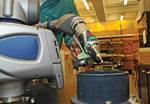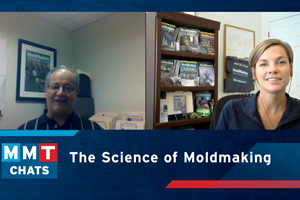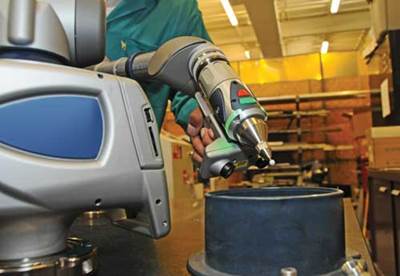Measurement Data Supports Manufacturing Success
Here are five ways that measurement data can be used to improve productivity and profits.
Collecting and analyzing data is an important part of the manufacturing process, whether you’re working with large molds, fabricated parts or batches of small components. Here are five ways that measurement data can be used to improve productivity and profits:
1. Shorten setup times. Long setup times compromise machine productivity and a shop’s overall capacity. Measurement data from inspection software can be used to simplify setups. The software can help establish the positional relationship between the part and the machine by adapting the machine’s coordinate measuring system and zero point. It makes positional corrections to the relationship between the part and the machine based on the measurement results. This optimizes the part’s position for the machining process. Using the calculated alignment enables machining with all six degrees of freedom: linear positioning, pitch, yaw, roll, and horizontal and vertical positioning. Faster and more consistent part setup results in improved machine utilization and reduces the need for operator intervention.
2. Identify tool wear. Tool wear results in a loss of dimensional accuracy and defective parts. High cutting speeds and temperatures challenge accuracy even further. Using data from machine tool probes can help maintain machine performance. Measuring dimensions that are critical to part acceptance/rejection after each cutting cycle and monitoring variations in the measurement data with statistical process control analysis allows operators to identify trends in variation, called process drift. An example of this drift is process variability that may arise from thermal expansion of the cutting tool or a change in the ambient temperature. With this knowledge, the operator can update machining coordinates before tool wear causes a nonconforming part. Minimal rework will improve a shop’s performance, and greater process control will facilitate unmanned, lights-out machining.
3. Compensate for variation. Although skilled operators may be able to compensate for part variation through post-finishing processes, such as polishing, finishing, deburring and trimming, this can be very costly and labor-intensive. Post-process, on-machine inspection allows the operator to quantify variation, allowing it to be compensated for automatically. Automated measurement processes are easier to replicate and allow skilled labor to be used more productively elsewhere.
4. Improve process repeatability. Machine tool probes can be used to ensure constant production quality. They allow tool wear to be monitored without the usual downtime associated with off-machine measurement. Surface inspection data also can be used to identify and predict maintenance requirements. For example, probing the part after roughing enables evaluation of the performance of the roughing program. If surface finish/geometry is not as expected, the cause may be probe wear. Probe performance varies most drastically with new probes and then stabilizes before varying again when the probe comes to the end of its life. By measuring before finish-machining, the operator can adapt the final process to prolong tool life and maintain an optimal surface finish. For example, depending on the amount of material to be removed in finish-machining, he or she can adapt the feed rate.
5. Certify mold/part quality. Every manufacturer needs accurate measurements to improve manufacturing performance. CAD and geometric dimensioning and tolerancing (GD&T) comparisons are two tools that can help ensure that individual parts fit and function as expected. This is especially useful if there is no access to mating parts. 3D-inspection software can determine feature size and geometric position, and produce clear inspection reports to certify that a mold/part has been machined within the acceptable tolerance.
Related Content
Leading Mold Manufacturers Share Best Practices for Improving Efficiency
Precise Tooling Solutions, X-Cell Tool and Mold, M&M Tool and Mold, Ameritech Die & Mold, and Cavalier Tool & Manufacturing, sit down for a fast-paced Q&A focused on strategies for improving efficiencies across their operations.
Read MoreMoldMaking Technology's Most-Viewed Content 2022: Products
MMT shares the five top-viewed technologies, equipment and services of 2022 in each Engineer, Build, Maintain and Manage tenet based on Google Analytics.
Read MoreSimulation is a Process, Not Just Software
To reap the benefits of simulation, you must view it as a process requiring you to change the way you work in part and mold design.
Read MoreMMT Chats: The Science of Moldmaking, Part 1
MoldMaking Technology Editorial Director Christina Fuges chats with Don Smith, North American Senior Tooling Engineer for Scholle IPN in Northlake, Illinois about the future and science of moldmaking.
Read MoreRead Next
Inspection/Measurement Advances Yield Better Molds Faster
A roundtable discussion of the latest trends and developments in mold inspection and measurement technology highlights the cycle time reduction, accuracy improvement and cost decrease benefits.
Read MoreReasons to Use Fiber Lasers for Mold Cleaning
Fiber lasers offer a simplicity, speed, control and portability, minimizing mold cleaning risks.
Read MoreAre You a Moldmaker Considering 3D Printing? Consider the 3D Printing Workshop at NPE2024
Presentations will cover 3D printing for mold tooling, material innovation, product development, bridge production and full-scale, high-volume additive manufacturing.
Read More








_300x250 3.png;maxWidth=300;quality=90)
.png;maxWidth=300;quality=90)



.jpg;maxWidth=300;quality=90)











